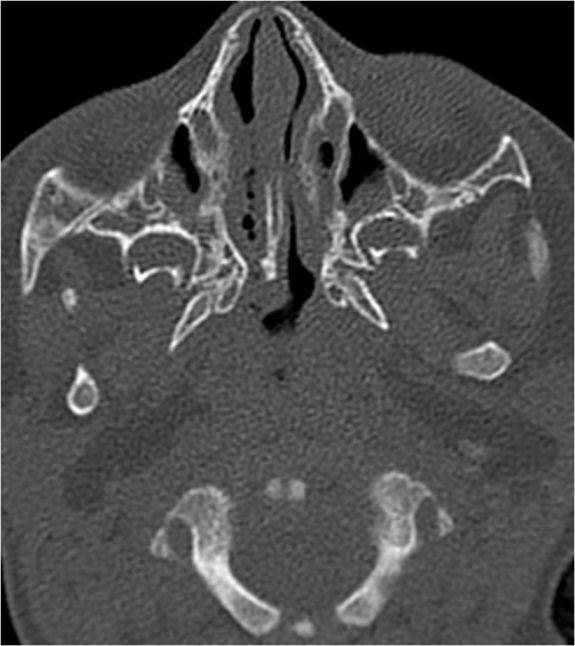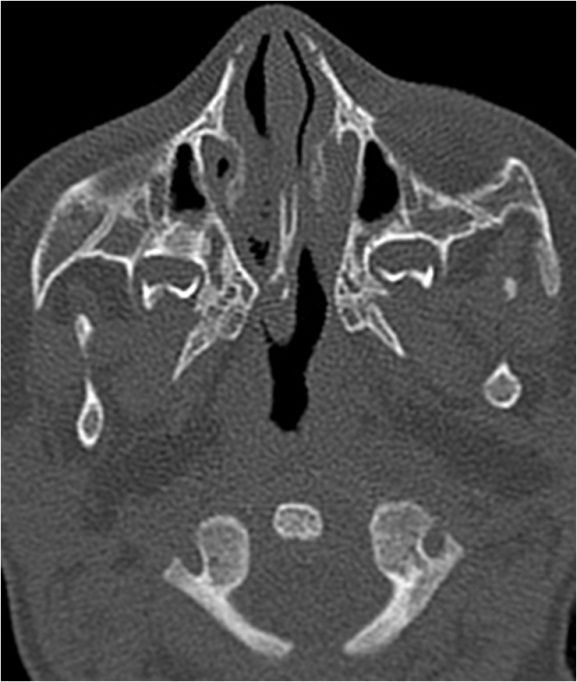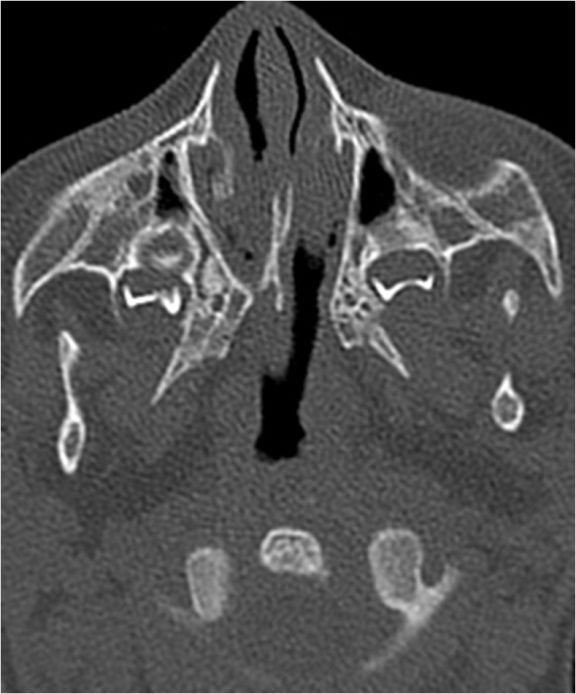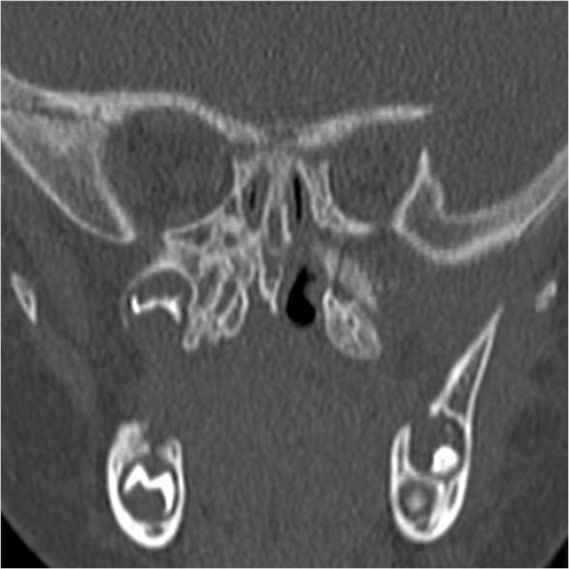- AI
- Molecular Imaging
- CT
- X-Ray
- Ultrasound
- MRI
- Facility Management
- Mammography
Choanal Atresia
CT scan diagnoses right choanal atresia in 6-month-old male child. Pre-surgical evaluation. Non-enhanced axial CT scan of paranasal sinuses.
Clinical History: A 6-month-old male child with right choanal atresia. Pre-surgical evaluation. Non-enhanced axial CT scan of paranasal sinuses.

Axial images show narrowing of right posterior choana
Findings: There is a severe bony narrowing seen involving the right choana with retained secretions in the right nasal cavity. The left choana is widely patent. Mucosal thickening is seen in both ethmoid and maxillary sinuses with opacification of both mastoid air cells. Both orbits are within normal limits. Visualized bones are unremarkable.

Axial images show severe bony narrowing seen involving the right choana with retained secretions in the right nasal cavity.

Axial images show severe bony narrowing seen involving the right choana with retained secretions in the right nasal cavity.

Axial images show bony choanal atresia

Axial images show bony choanal atresia

Coronal images shows narrowing of right choana

Coronal Images shows bony choanal atresia
Choanal atresia is a congenital disorder where the back of the nasal passage (choana) is blocked, usually by abnormal bony or soft tissue formed during fetal development.
Presentation: It can be unilateral or bilateral. Sometimes, a unilateral choanal atresia is not detected until much later in life because the baby manages to get along with only one nostril available for breathing. Bilateral choanal atresia is a very serious life-threatening condition because the baby will then be unable to breathe directly after birth as babies are obligate nasal breathers (they must use their noses to breathe). In some cases, this may present as cyanosis while the baby is feeding, because the oral air passages are blocked by the tongue, further restricting the airway. The cyanosis may improve when the baby cries, as the oral airway is used at this time. These babies may require airway resuscitation soon after birth.
Epidemiology: The average rate of choanal atresia is 0.82 cases per 10,000 individuals. Unilateral atresia occurs more frequently on the right side. The ratio of unilateral to bilateral cases is 2:1. A slightly increased risk exists in twins. Maternal age or parity does not increase the frequency of occurrence. Chromosomal anomalies are found in 6 percent of infants with choanal atresia. Five percent of patients have monogenic syndromes or conditions. Choanal atresia occurs with equal frequency in people of all races. More studies report significantly more females than males affected.
Pathophysiology: A number of theories have been proposed to explain the occurrence of choanal atresia, and they can be summarized as follows:
• Persistence of the buccopharyngeal membrane
• Failure of the bucconasal membrane of Hochstetter to rupture
• Medial outgrowth of vertical and horizontal processes of the palatine bone
• Abnormal mesodermal adhesions forming in the choanal area
• Misdirection of mesodermal flow due to local factors
Associated Conditions: Many patients have an associated narrowed nasopharynx, widened vomer, medialized lateral nasal wall, and/or arched hard palate. Associated malformations occur in 47 percent of infants without chromosome anomalies. Nonrandom association of malformations can be demonstrated using the CHARGE association, which appears to be overused in clinical practice.
The components of the CHARGE association are as follows:
• Coloboma of the iris, choroid, and/or microphthalmia
• Heart defect such as atrial septal defect (ASD) and/or conotruncal lesion
• Atresia of choanae
• Retarded growth and development
• Genitourinary abnormalities such as cryptorchidism, microphallus, and/or hydronephrosis
• Ear defects with associated deafness (The external, middle, and/or inner ear may be involved.
Only a small proportion of infants with choanal atresia and related components probably represent this entity.)
Diagnosis: Choanal atresia can be suspected if it is impossible to insert a nasal catheter. Also, if one notices a continuous stream of mucous draining from one or both nostrils, it could be a sign of an atresia. Diagnosis is confirmed by radiological imaging, usually CT scan.
Diagnostic Procedures:
• Failure to pass an 8F catheter through the nasal cavity more than 5.5 cm from the alar rim
• The lack of movement of a thin wisp of cotton under the nostrils while the mouth is closed
• The absence of fog on a mirror when it is placed under the nostrils
• Acoustic rhinometry
• Listening for breath sounds with either a stethoscope or a Toynbee auscultation tube
• Gently blowing air into each nasal cavity with a Politzer bag
• Administering into the nose a colored solution that is visible in the pharynx
Treatment: The immediate concern is to resuscitate the baby if necessary. An airway may need to be placed so that the infant can breathe. In some cases, intubation or tracheostomy may be needed.
An infant can learn to mouth breathe, which can delay the need for immediate surgery.
Surgery to remove the obstruction cures the problem. Surgery may be delayed if the infant can tolerate mouth breathing. The surgery may be done through the nose (transnasal) or through the mouth (transpalatal).
Sushila Ladumor, MD, FRCR, consultant radiologist with multi-modality imaging experience, working in Medical Imaging Department, King Abdulaziz Medical City, Riyadh, Saudi Arabia.
References:
http://emedicine.medscape.com/article/872409-treatmenthttp://www.atresia.info/choanal-atresia.htmhttp://health.nytimes.com/health/guides/disease/choanal-atresia/overview.htmlhttp://en.wikipedia.org/wiki/Choanal_atresia
AI Adjudication Bolsters Chest CT Assessment of Lung Adenocarcinoma
April 11th 2024The inclusion of simulated adjudication for resolving discordant nodule classifications in a deep learning model for assessing lung adenocarcinoma on chest CT resulted in a 12 percent increase in sensitivity rate.
Five-Year Study Shows Significant Overuse of CT Angiography in the ER
April 2nd 2024Researchers noted a 67.4 percent increase in head and neck CT angiography and a 38 percent reduction in findings of acute pathology in a recent comparison of 2017 and 2021 statistics for headache and/or dizziness presentations at the emergency department of an urban academic medical center.
The Reading Room: Racial and Ethnic Minorities, Cancer Screenings, and COVID-19
November 3rd 2020In this podcast episode, Dr. Shalom Kalnicki, from Montefiore and Albert Einstein College of Medicine, discusses the disparities minority patients face with cancer screenings and what can be done to increase access during the pandemic.
FDA Clears CT-Based AI Tools for PE Detection and Stroke Severity Assessment
March 26th 2024The artificial intelligence (AI) modalities CINA-iPE and CINA-ASPECTS may facilitate improved detection of incidental pulmonary embolism and stroke evaluation, respectively, based on computed tomography (CT) scans.
